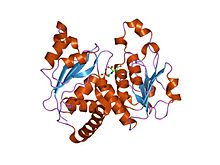ATCase/OTCase family
| Aspartate/ornithine carbamoyltransferase, carbamoyl-P binding domain | |||||||||
|---|---|---|---|---|---|---|---|---|---|
 the pala-liganded aspartate transcarbamoylase catalytic subunit from pyrococcus abyssi | |||||||||
| Identifiers | |||||||||
| Symbol | OTCace_N | ||||||||
| Pfam | PF02729 | ||||||||
| InterPro | IPR006132 | ||||||||
| PROSITE | PDOC00091 | ||||||||
| SCOP2 | 1raa / SCOPe / SUPFAM | ||||||||
| |||||||||
| Aspartate/ornithine carbamoyltransferase, Asp/Orn binding domain | |||||||||
|---|---|---|---|---|---|---|---|---|---|
| Identifiers | |||||||||
| Symbol | OTCace | ||||||||
| Pfam | PF00185 | ||||||||
| SCOP2 | 1raa / SCOPe / SUPFAM | ||||||||
| |||||||||
In molecular biology, the ATCase/OTCase family is a protein family which contains two related enzymes: aspartate carbamoyltransferase EC 2.1.3.2 and ornithine carbamoyltransferase EC 2.1.3.3. It has been shown that these enzymes are evolutionary related.[1] The predicted secondary structure of both enzymes is similar and there are some regions of sequence similarities. One of these regions includes three residues which have been shown, by crystallographic studies to be implicated in binding the phosphoryl group of carbamoyl phosphate and may also play a role in trimerisation of the molecules.[2][3] The N-terminal domain is the carbamoyl phosphate binding domain. The C-terminal domain is an aspartate/ornithine-binding domain.
Aspartate carbamoyltransferase (ATCase) catalyses the conversion of aspartate and carbamoyl phosphate to carbamoylaspartate, the second step in the de novo biosynthesis of pyrimidine nucleotides.[4] In prokaryotes ATCase consists of two subunits: a catalytic chain (gene pyrB) and a regulatory chain (gene pyrI), while in eukaryotes it is a domain in a multi- functional enzyme (called URA2 in yeast, rudimentary in Drosophila, and CAD in mammals) that also catalyzes other steps of the biosynthesis of pyrimidines.[5]
Ornithine carbamoyltransferase (OTCase) catalyses the conversion of ornithine and carbamoyl phosphate to citrulline. In mammals this enzyme participates in the urea cycle and is located in the mitochondrial matrix.[6] In prokaryotes and eukaryotic microorganisms it is involved in the biosynthesis of arginine. In some bacterial species it is also involved in the degradation of arginine (the arginine deaminase pathway).[7]
References[edit]
- ^ Houghton JE, Bencini DA, O'Donovan GA, Wild JR (August 1984). "Protein differentiation: a comparison of aspartate transcarbamoylase and ornithine transcarbamoylase from Escherichia coli K-12". Proceedings of the National Academy of Sciences, USA. 81 (15): 4864–4868. doi:10.1073/pnas.81.15.4864. PMC 391592. PMID 6379651.
- ^ Ke HM, Honzatko RB, Lipscomb WN (July 1984). "Structure of unligated aspartate carbamoyltransferase of Escherichia coli at 2.6-A resolution". Proceedings of the National Academy of Sciences, USA. 81 (13): 4037–4040. doi:10.1073/pnas.81.13.4037. PMC 345363. PMID 6377306.
- ^ Beernink PT, Endrizzi JA, Alber T, Schachman HK (May 1999). "Assessment of the allosteric mechanism of aspartate transcarbamoylase based on the crystalline structure of the unregulated catalytic subunit". Proceedings of the National Academy of Sciences, USA. 96 (10): 5388–5393. doi:10.1073/pnas.96.10.5388. PMC 21869. PMID 10318893.
- ^ Lerner CG, Switzer RL (August 1986). "Cloning and structure of the Bacillus subtilis aspartate transcarbamylase gene (pyrB)". Journal of Biological Chemistry. 261 (24): 11156–11165. doi:10.1016/S0021-9258(18)67362-4. PMID 3015959.
- ^ Davidson JN, Chen KC, Jamison RS, Musmanno LA, Kern CB (March 1993). "The evolutionary history of the first three enzymes in pyrimidine biosynthesis". BioEssays. 15 (3): 157–164. doi:10.1002/bies.950150303. PMID 8098212. S2CID 24897614.
- ^ Takiguchi M, Matsubasa T, Amaya Y, Mori M (May 1989). "Evolutionary aspects of urea cycle enzyme genes". BioEssays. 10 (5): 163–186. doi:10.1002/bies.950100506. PMID 2662961. S2CID 33482491.
- ^ Baur H, Stalon V, Falmagne P, Luethi E, Haas D (July 1987). "Primary and quaternary structure of the catabolic ornithine carbamoyltransferase from Pseudomonas aeruginosa. Extensive sequence homology with the anabolic ornithine carbamoyltransferases of Escherichia coli". European Journal of Biochemistry. 166 (1): 111–117. doi:10.1111/j.1432-1033.1987.tb13489.x. PMID 3109911.
